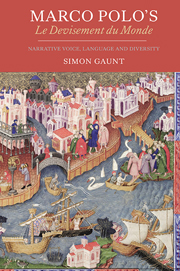Book contents
- Frontmatter
- Contents
- Illustrations
- Acknowledgements
- Abbreviations and a note on citations and editions
- Introduction: Le Devisement du Monde: textual tradition and genre
- 1 Narrative voice and style: ‘ego Marcus Paulo’
- 2 Language and translation: ‘in lingua Galica dicitur’
- 3 Knowledge, marvels and other religions: ‘oculis propriis videt’
- 4 Diversity and alterity: ‘diversarum regionum mundanas diversitates’
- Conclusion: et ipse non notavit nisi pauca aliqua, que adhuc in mente retinebat
- Bibliography
- Index
- Already Published
Introduction: Le Devisement du Monde: textual tradition and genre
Published online by Cambridge University Press: 05 September 2013
- Frontmatter
- Contents
- Illustrations
- Acknowledgements
- Abbreviations and a note on citations and editions
- Introduction: Le Devisement du Monde: textual tradition and genre
- 1 Narrative voice and style: ‘ego Marcus Paulo’
- 2 Language and translation: ‘in lingua Galica dicitur’
- 3 Knowledge, marvels and other religions: ‘oculis propriis videt’
- 4 Diversity and alterity: ‘diversarum regionum mundanas diversitates’
- Conclusion: et ipse non notavit nisi pauca aliqua, que adhuc in mente retinebat
- Bibliography
- Index
- Already Published
Summary
Marco Polo
‘Marco Polo is one of those comparatively few people from the thirteenth and fourteenth centuries of whom everyone today has heard.’ Thus begins one of the most authoritative historical studies of this venetian merchant, who was probably born in 1254 and who died on 9 January 1324. Airports and cars are named after him; he has been the subject of numerous children's books from the nineteenth century onwards; he makes guest appearances in Dr Who; and popular histories of his life appear with regularity every few years, which suggests he continues to fascinate. The name Marco Polo remains a byword for intrepid travel, particularly to Asia and the Indian Ocean, and for the observation by Europeans of exotic lands. Marco's fame, however, is not merely a modern phenomenon: his travels in Asia meant he was a celebrity for the last twenty-five years of his life, not only in Venice but throughout Europe, and the memory of his travels remained alive throughout the Middle Ages, inspiring Christopher Columbus, no less, to sail west in the hope of reaching the lands Marco had visited by travelling east. Marco Polo is an iconic figure for European culture and for its relations with the rest of the world.
- Type
- Chapter
- Information
- Marco Polo's Le Devisement du MondeNarrative Voice, Language and Diversity, pp. 1 - 40Publisher: Boydell & BrewerPrint publication year: 2013



